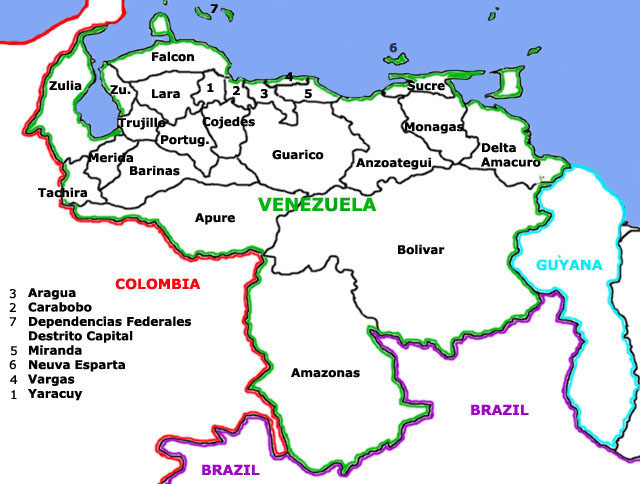Venezuela Dilophonotini
|
|
Updated as per personal communication with María Esperanza Chacín; April 1, 2005
Updated as per Hawkmoths of the World Kitching and Cadiou, 2000; May 2011
Updated as per CATE Sphingidae, 2009; May 17, 2011
Updated as per personal communication with Jose Ramon Alvarez Corral; May 27, 2012
|
Venezuela Dilophonotini:
Aellopos, Eupyrrhoglossum, Nyceryx, Perigonia, Stolidoptera
This checklist will become more accurate as images and information are sent to me. If you would like
to assist in the development of this worldwide Sphingidae data/image
base, please send info and images to Bill Oehlke.
All images I receive remain the property of respective photographers and are credited as such.
Data such as wingspan, date, elevation, precise location, etc., is credited to persons who submit same.
I have arranged the images in accordance with my perception of wing characters: predominent markings, shape, colour,
size.
There are probably some Venezuelan species not listed below, and there are some species not officially confirmed for Venezuela, although
I think they have a good chance of being found there.
All images that I use are credited to respective photographers and those images remain the property of the photographers. Data submissions are also acknowledged.
I hope that over the next twenty years the site can be further refined to allow for the creation of state by state checklists for Venezuela.
Many thanks to those who have already submitted photos and information. The CATE Sphingidae site has been extremely helpful regarding descriptions and determinations.
If there are mistakes on this site, they are my own. Bill Oehlke.
Females often have a wing shape or pattern that differs from the males. I hope some day to also have a thumbnail checklist for the females.
Nyceryx
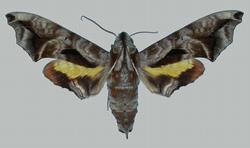
Nyceryx maxwelli:
Several dark patches against lavender-grey ground colour.
Similar to Nyceryx continua cratera but apex of hindwing upperside brown and
tornal area not yellow. Hindwing upperside with yellow basal area not extending beyond 1A,
and apex brownish-orange (not dark brown).
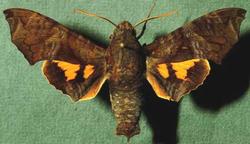
Nyceryx coffaeae
Almost uniform dark brown ground colour.
Outer margin not deeply hollowed out below apex, instead o.m. divided into two roughly equal, almost straight (slightly concave)
edges with slight bulge at their juncture.
Large, slightly darker trapezoid with base along inner margin, extending to bottom of cell.
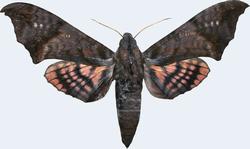
Nyceryx hyposticta
Large species.
Fw: Semitransparent spots in distal half.
Arc from above cell to anal angle is recurved at cell.
Double, convex am lines: dark interior in lower half.
Hw: pink, three transverse black bands.
|
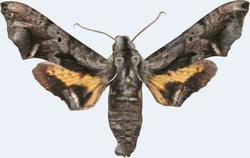
Nyceryx continua cratera:
Similar to Nyceryx maxwelli but apex of hindwing upperside is brownish-orange and
tornal area is yellow.
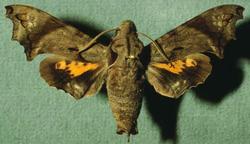
Nyceryx ericea
Prominent diffuse, dark arc, upwardly convex, from near midpoint of costa to anal angle.
Thin, dark, scalloped arc from apex to anal angle.
Semitransparent spots in the distal half of the forewing.
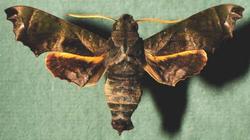
Nyceryx tacita
Prominent small white triangular patch in upper half of subterminal area.
Strong dark green suffusions over dark brown in costal regions.
Large dark triangular patch with base from body to midpoint along inner margin with right angle to costa.
Significant pale lines define other dark patches.
|
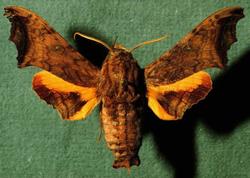
Nyceryx riscus
Diffuse, very dark, somewhat angular arc from apex to anal angle.
Fine but distinct lines over reddish brown ground colour.
Lacks significant addition markings on forewing.
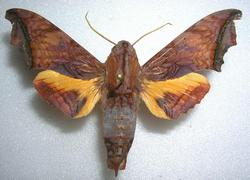
Nyceryx stuarti
Two black, subparallel, concave lines determnie a smooth arc from apex to anal angle with
marginal area and space between two black lines filled with light grey scaling.
Small light grey patch along inner margin. Fine lines over reddish brown ground colour.
|
|
Perigonia
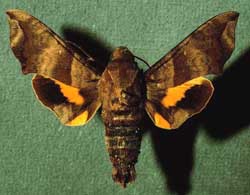
Perigonia ilus
Lacks solid, dark apical crescent to mid bulge, instead a diffuse, dark arc with lighter
internal scaling.

Perigonia lusca :
Fw: Dark, slightly irregular, inwardly concave, thick line runs from apex to anal angle.
Prominent, straight, dark aml outwardly shaded in dark brown more widely along inner angle, tapers toward costa.
Outer margin, oblique, almost straight.
Small black dot at base of costa midpoint, slightly larger black, short black streak in cell.
Hw yellow band very variable.
|

Perigonia pallida
Similar to Perigonia stulta but generally paler, forewings narrower.
Hindwing upperside very similar to Perigonia stulta but brown border narrower and basal patch deeper yellow-orange tint.
Both species with solid, dark crescent apex to midwing bulge; pallida with less pointed apex.

Perigonia pittieri
Perigonia pittieri: very similar to Perigonia stulta, but pittieri's forewing outer margin is more evenly curved
(not crenulated as in [some] Perigonia stulta); apex is obtuse instead of acute.
Fw pattern less contrasting, more uniform than in stulta, antemedian band straight, or only slightly curved.
|

Perigonia stulta:
Crenulations of forewing outer margin are variable in degree of development, but greatly produced near midpoint.
Forewing upperside lacks distinct grey-brown or pale brown lunate patch on the outer margin.
Forewing underside submarginal line distinct at least from the apex to M2, bordered with grey distally.
|
|
Stolidoptera
The forewing apex is very produced, almost bulbous and is
more toward mustard yellow compared to darker greenish-brown of rest of wing.
Tiny black cell spot.
Lines irregular, slightly diffuse but distinct.
Fw outer margin unique in both male and female.
|
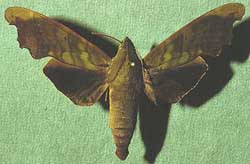
Stolidoptera tachasara
|
|
|
Use your browser "Back" button to return to the previous page.
Visit Sphingini: Manduca
Visit Sphingini: Agrius, Amphimoea, Cocytius, Euryglottis, Lintneria, Sphinx
Visit Smerinthini: Adhemarius and Protambulyx
Visit Dilophonotini: Aleuron, Baniwa, Enyo, Kloneus, Pachygonidia and Unzela
You are here: Dilophonotini: Aellopos, Eupyrrhoglossum, Nyceryx, Perigonia and Stolidoptera
Visit Dilophonotini: Callionima, Erinnyis, Hemeroplanes, Isognathus, Madoryx, Oryba, Pachylia, Pachylioides, Phryxus
and Pseudosphinx
Visit Philampelini: Eumorpha
Visit Macroglossini: Hyles and Xylophanes
Use your browser "Back" button to return to the previous page.
This page is brought to you by
Bill Oehlke and the
WLSS. Pages are on space rented from Bizland. If you would like
to become a "Patron of the Sphingidae Site", contact Bill.
Please send sightings/images to Bill. I will do my best to respond to
requests for identification help.
 | 
Show appreciation for this site by clicking on flashing butterfly to the left.
The link will take you to a page with links to many insect sites. |
